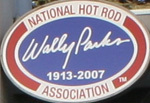NHRA exhibit chronicles 50 years of Azusa’s Gale Banks Engineering
Pasadena Star-News December 4, 2008
POMONA – There were a lot of horses and a lot of power in a Fairplex museum on Wednesday. But it had nothing to do with a barn.
That’s because 50 years of ramping up the internal combustion engine to make it go faster, longer and better went on display in the NHRA Wally Parks Motorsports Museum.
POMONA – There were a lot of horses and a lot of power in a Fairplex museum on Wednesday. But it had nothing to do with a barn.
That’s because 50 years of ramping up the internal combustion engine to make it go faster, longer and better went on display in the NHRA Wally Parks Motorsports Museum.
It was the work of Gale Banks, the owner of Azusa-based Gale Banks Engineering, the business he started in 1958.
Since then, his company has made a variety of power-enhancing products for diesel and gas-powered light trucks, motorhomes, SUVs, Jeeps, Hummers and boats.
But the real gems – the record-breakers – were on display Wednesday, as eager auto fans crowded the museum to get a glimpse of the man and the machines he made go really fast.
There was Banks’ Twin-Turbo Pontiac Trans Am, which for 10 years beginning in 1987 was the world’s fastest stock-booked passenger car running on gasoline at 268 miles mph. But if that wasn’t enough speed, visitors set their eyes on the world’s first diesel road-racing pickup, a GMC Sierra, as well as a record-setting modified 1953 Studebaker. Twin-turbocharged racing engines were also on display.
Banks was reflective.
“The last 50 years of my life is here,” he said.
Banks celebrated California’s unique position in culture of cars.
“This the mother lode of car culture,” he said.
But the industry behind that culture is shifting, he said.
Even at his own business, where speed and power are at the core, energy efficiency has emerged as a vital component of his philosophy.
Diesel power can be a key part of that efficiency, and he’s got the automakers listening.
Chevrolet, GMC, Buick, Volvo and Pontiac have all turned to Banks’ company as they research and develop cars for what is next.
It’s a future that hangs in the balance these days, as the nation’s major automakers, Ford, GM and Chrysler teeter on the edge of going out of business if they don’t get billions in government bridge loans.
And that possibility was not far from Banks’ mind on Wednesday.
“When I was a kid, I thought God lived in Detroit,” he said, adding that recent events confirm another conclusion: that the automakers are mortal.
But despite their trouble, Banks was optimistic.
“Detroit has got a market that’s viable,” he said.
More efficient vehicles exist in the American automakers’ fleet that can sell, he said. And the automakers’ have the talent and experience to make profitable vehicles in the future.
But they can do that only if they make products that people have an emotional connection to, while being fuel efficient.
“They need to push that, and push the iron that people are looking for,” he said. “I’m an environmentalist and I hot-rod.”
But the answer to Detroit’s woes is not a governmental bailout, he said, adding that the market needs to play itself out, and from the ruins, allow a new auto industry to prop up.
“We’re just delaying the inevitable,” he said. “It’s a shame. I hope I’m wrong.”
Others on Friday had opinions about Banks and the industry.
Jim Deist, a pioneer in racing safety and a La Crescenta resident, was on hand Wednesday. Deist, who developed many motorsport products such as the drag chute, said Banks was a key player in getting better mileage and performance out of the engine.
It’s the kind of performance the industry should refocus on to get it out of the doldrums, he said.
“What they’ve got to do is go back 40 years and start building cars like they used to,” he said, adding that in the 1940s, a Cadillac was developed that could get 20 miles a gallon.
That was before the mid-1970s, when catalytic converters and other add-ons, brought it down to about 6 miles a gallon, he said.
The exhibit will continue until September 2009 at the museum, 1101 W. McKinley Ave., Building 3A, Pomona. Visit www.museum.nhra.com for more information.
(626) 962-8811, Ext. 2720

See all the stories from the Wally Parks NHRA Motorsports Museum
here »

